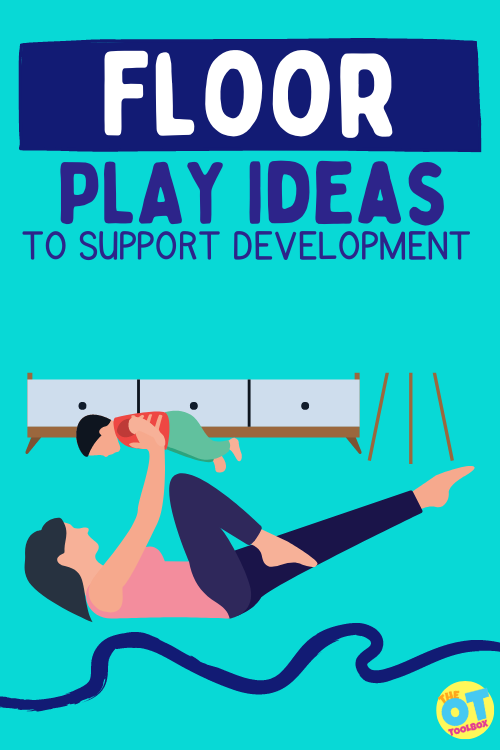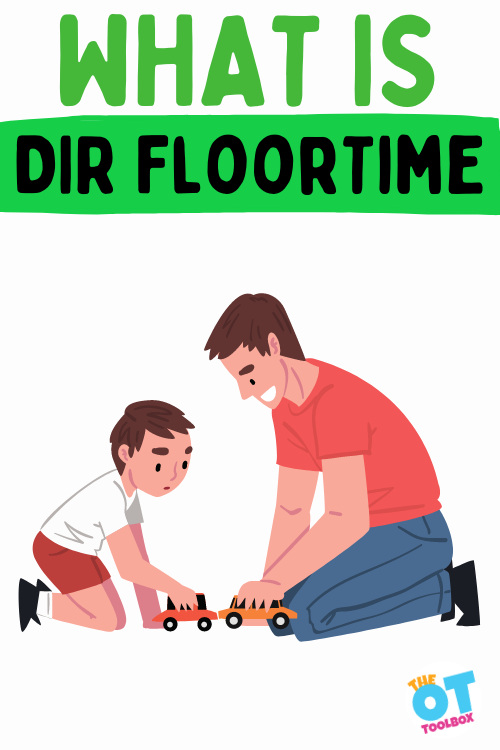Have you heard of DIR Floortime as a tool for helping children thrive and achieve their greatest potential? Occupational therapy professionals often use Floortime, or the DIRFloortime (or Floortime for short) as one of the tools in their therapy toolbelt. The fact is that floor play for infants, babies, and toddlers is so effective in many aspects of play, but we wanted to cover a bit more about the Floortime approach to development and learning.
In this post we will explore the various types of floor play, including DIR Floortime, for children of all ages, as well as explain why playing on the floor with your child is important. Play age and stage of development guides DIR floortime as well as floor play in a general sense.

What is Floor Play?
First, let’s cover what we mean by floor play. In this blog post, what we mean by floor play is just that: play on the floor!
Children will play just about anywhere – most are skilled at making any landscape their personal playground. The most commonly accessible playground, however, is the floor! So much play and movement can happen on the floor, which makes it a perfect location for developmental milestones to occur in little ones. Older children continue to be drawn to the floor as they sit down to play with trucks, dolls, and build forts.
When babies and infants are on the floor, they can develop and learn during tummy time, but also while on a play mat in a variety of positions.
Older babies strengthen their bodies and learn how their movements are in their own control while playing on the floor. They learn about the world around them this way. They gain motor skills and begin to engage with toys through play on the floor.
Toddlers develop social emotional skills, refined motor skills, strength, coordination, and eye-hand coordination skills through floor play.
Older children build more strength, endurance, postural control, social emotional skills, confidence, self-regulation, and executive functioning skills through floor play.
There are so many benefits to getting down on the ground with your child an engaging in floor play, no matter the age!
Related, this article on parallel play describes additional information on play at different ages and stages.
Floor Play For Babies
Why should I put my baby on the floor? Isn’t it dirty? How do I keep them safe down there?
Check out this post on Floor Play for Babies for a specific floor play idea for young children.
For young children, movement may be reduced as a result of placing babies in “containers” or seats. This limited movement opportunity can impact typical development and reflex integration.

Floor Play Activities
Isn’t it dirty? Some floors are dirty. Some houses have dirt floors. Never take for granted that your patient has a great/clean environment to play on the floor. Provide a washable tablecloth, sheet, blanket, or large mattresses on the floor to encourage movement.
In fact, playing on the floor with our children is so important that a model was born from it, called DIR Floortime.
What is DIR Floortime?
DIR Floortime stands for Developmental, Individual-Differences, and Relationships. It is a model used primarily to guide caregivers of children with Autism Spectrum Disorder (ASD). As you can imagine, this model guides parents to use the most important place for child-led play,…the floor!
The DIR Floortime model emphasizes the importance of following a child’s lead, joining them on the floor, at their height, playing with them based on their choices.
dir floortime is different than other programs
Many programs for Autistic children are designed to help them change, in order to act more like children without Autism. However, this can be an area of concern. Floortime therapy encourages acceptance and appreciation of who the child is, and highlights that caregivers can best support the child by following their lead.
Through this type of interaction, caregivers can build strong relationships, and improve the social-emotional skills of the child.
DIR Floortime training is a certification process that teaches and promotes an approach to intervention. The training is appropriate and targeted for therapy professionals working in preschool through school-aged students. Through the DIR/Floortime principles, therapy professionals learn and intervene through practice, self-reflection, and mentorship, while meeting the needs of their clients in different environments and settings.
Although DIR Floortime interventions are primarily used as a model to better understand and build relationships between an ASD child and their caregiver, I find it a great model for any child-adult relationship.
Learn more about DIR Floortime principles on their website.
Playing on the floor with your child not only leads to gains in motor development, but as DIR Floortime and various researchers report, playing on the floor is also integral to the development of social and emotional skills! It’s a win-win-win.
floor time Activities by Age:
As your baby ages into a toddler and into a child, they will continue to benefit from playing on the floor with you.
Infants and Babies
Floorplay activities for babies is a good resource to check out when it comes to development and the infant/baby. It’s during the early years that the young baby support development of motor, sensory, and cognitive skills. It’s important to engage with your baby during floor play time, both when laying in tummy time or on their backs or sides.
Babies should be interacted with during floor time play, and not just placed on the floor with some toys or a play mat.
Some activities for this age include playing on the floor and engaging with baby by:
- Singing songs
- Getting close to baby’s face and making eye contact
- Baby massage
- Rubbing baby’s back while humming or singing
During the vast stages of baby development, floor play is about engaging with your little one. Tummy time can still be a challenge for this age, but keep going! This is a great age to engage with eye contact, physical contact while supporting emotional development and continued motor and cognitive skills.
Spend a lot of time talking to baby during floor play. Use different tones of voice, and make sounds with your mouth and tongue when talking and playing to baby. This is a great way to develop auditory processing skills, too.
Floor play during the first year can include (among many other play ideas) a means for motor skill development too:
- Play mats
- Toys scattered on the floor to encourage reaching, rolling, and sitting
- Sing and speak nursery rhymes and gently move baby’s arms and legs during floor play
- Supporting baby on lap and reading books, talking, and interacting/engaging with baby
- Mirror play
For older children: toddlers, preschoolers, and older kids, floortime is a fantastic way to support development through engaging with the little one in a respectful and playful way. Floorplay is fun! It’s a joyful way to support a young child’s development.
When it comes to specific activities and play ideas, the most important thing to remember is to make the play time meaningful. This looks like themes or activities that align with the individual’s interests.
Consider the following when coming up with floor time activities:
- Favorite topics
- Favorite characters (from TV, movies, books, games, videos, etc.)
- Favorite colors
- Preferred activities
- Sports
- Seasonal activities
While floortime can cover any topic or theme, the most important piece is getting down on the floor with the child and playing! Let the play be guided by the child and
the best part of floor play
The best part of floor play, is how easy and inexpensive it is to support your child by playing on the floor with them. You don’t need the “best” toys or even any traditional toys at all. Your body, voice, household objects (blankets, paper, remote control, books), creativity, and a positive attitude will go for miles.
For even more ideas of how to play with your infant or child on the floor, check out this great post for toddler play ideas.

Sydney Thorson, OTR/L, is a new occupational therapist working in school-based therapy. Her
background is in Human Development and Family Studies, and she is passionate about
providing individualized and meaningful treatment for each child and their family. Sydney is also
a children’s author and illustrator and is always working on new and exciting projects.






